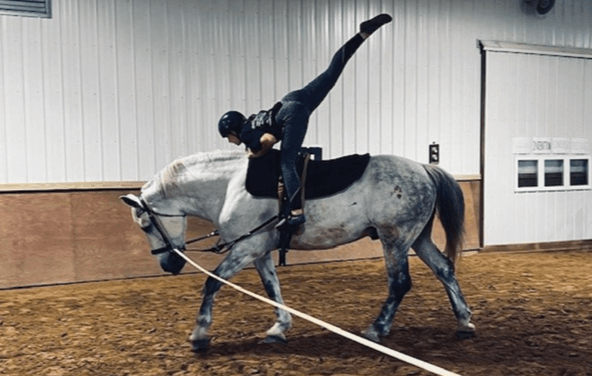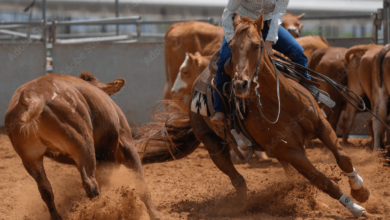What are the basic moves and routines in equestrian vaulting?

Understanding Equestrian Vaulting
Equestrian vaulting, often referred to simply as vaulting, is a dynamic sport combining elements of gymnastics, dance, and horseback riding. Vaulters perform various gymnastic exercises on a moving horse, showcasing their agility, balance, and harmony with the horse.
The History of Equestrian Vaulting
Vaulting dates back to ancient Roman games, where acrobats performed on cantering horses. The modern version of the sport gained popularity in the mid-20th century, particularly in Europe, and has since evolved into an internationally recognized discipline.
Equipment Used in Equestrian Vaulting
Vaulting requires specific equipment, including a vaulting surcingle, which is a type of saddle with handles and a back pad. Vaulters also use a lunge line and a long whip to control the horse’s movement, ensuring a steady and controlled pace.
Basic Moves in Equestrian Vaulting
Vaulting Seat
The vaulting seat is the foundational position where vaulters sit upright on the horse, maintaining balance and a straight posture. It’s essential for performing other moves and serves as a resting position.
Flag
In the flag position, vaulters extend one leg and one arm to create a straight line with their body, balancing on the horse with the other leg and arm. This move demonstrates control and balance.
Mill
The mill involves a series of movements where the vaulter swings their legs in a circular motion around the horse. It requires coordination and timing, making it a fundamental move in vaulting routines.
Scissors
Scissors is a move where vaulters perform a split jump, transitioning from facing forward to backward. It’s a dynamic move that showcases flexibility and precision.
Stand
Standing on the horse while it moves is a hallmark of vaulting. Vaulters start from the kneeling position, gradually rising to stand while maintaining balance.
Kneel
The kneel position involves vaulters kneeling on the horse’s back with an upright posture. It’s a stable position used as a transition for other moves.
Flank
The flank is a move where vaulters dismount by swinging their legs over the horse’s back in a controlled manner. It’s often used as a concluding move in routines.
Reverse Scissors
Similar to the scissors, the reverse scissors involves performing a split jump but in the opposite direction, transitioning from backward to forward.
Swing
The swing involves vaulters swinging their legs back and forth while holding the surcingle handles. It’s a move that tests strength and rhythm.
Free Kneel
The free kneel is an advanced variation of the kneel position where vaulters balance on their knees without holding the surcingle, relying solely on their core strength.
Beginner Routines
Individual Vaulting Routine
Beginners often start with individual routines, combining basic moves like the vaulting seat, flag, and kneel. This routine focuses on developing balance and coordination.
Pas de Deux Routine
In a Pas de Deux routine, two vaulters perform synchronized moves on the same horse. It requires teamwork and precise timing to execute the moves harmoniously.
Team Routine
Team routines involve multiple vaulters performing coordinated exercises on and off the horse. This routine emphasizes collaboration and complex formations.
Intermediate Moves and Routines
Half-Mill
The half-mill is an intermediate move where vaulters perform half of the mill motion, adding a level of difficulty to the basic mill.
Shoulder Stand
In the shoulder stand, vaulters balance on their shoulders while elevating their legs, showcasing strength and balance.
Double Kneel
The double kneel involves two vaulters kneeling on the horse simultaneously, requiring precise coordination and balance.
Freestyle Routine
Freestyle routines allow vaulters to incorporate creative elements and personalized sequences, combining intermediate moves to create a unique performance.
Advanced Moves and Routines
Stand on Shoulder
The stand on shoulder is an advanced move where vaulters stand on each other’s shoulders while balancing on the horse. It’s a challenging move requiring trust and precision.
Handstand
Performing a handstand on a moving horse is a pinnacle of vaulting skill. Vaulters balance on their hands, showcasing exceptional strength and control.
Aerials
Aerial moves involve vaulters performing flips and jumps off the horse, adding a dynamic and acrobatic element to the routine.
Advanced Freestyle Routine
Advanced freestyle routines incorporate high-level moves and creative choreography, pushing the limits of vaulting skills and artistic expression.
Safety Tips in Equestrian Vaulting
Safety Gear
Wearing appropriate safety gear, including helmets and padding, is crucial to prevent injuries during practice and performances.
Warm-Up Exercises
Warm-up exercises prepare the body for the physical demands of vaulting, reducing the risk of muscle strains and injuries.
Spotting Techniques
Having spotters during training sessions ensures safety, as they can assist in preventing falls and providing immediate support if needed.
Training and Conditioning for Vaulters
Flexibility Exercises
Flexibility exercises enhance the range of motion, allowing vaulters to perform moves with greater ease and grace.
Strength Training
Strength training builds the muscle power needed for lifting, balancing, and holding positions on the horse.
Balance Drills
Balance drills improve stability and coordination, essential for maintaining control during vaulting moves.
Choosing the Right Horse for Vaulting
Horse Temperament
A suitable vaulting horse should have a calm temperament and be comfortable with the presence of vaulters on its back.
Training the Vaulting Horse
Training a vaulting horse involves gradual desensitization to movements and sounds, ensuring it remains calm and steady during routines.
Horse Care and Maintenance
Regular grooming, veterinary check-ups, and proper nutrition are essential for maintaining the health and well-being of a vaulting horse.
Vaulting Competitions and Scoring
Competition Levels
Vaulting competitions are categorized into different levels, ranging from beginner to advanced, allowing vaulters to compete against others of similar skill levels.
Scoring Criteria
Judges score vaulting routines based on technical execution, artistic expression, and harmony with the horse. Points are awarded for precision, creativity, and difficulty.
Preparing for Competitions
Preparing for competitions involves rigorous training, perfecting routines, and ensuring both vaulter and horse are in peak condition.
Frequently Asked Questions (FAQs)
What are the basic moves and routines in equestrian vaulting?
The basic moves in equestrian vaulting include the vaulting seat, flag, mill, scissors, stand, kneel, flank, reverse scissors, swing, and free kneel. Beginner routines often combine these moves in individual, Pas de Deux, and team performances.
How can I improve my balance for vaulting?
Improving balance for vaulting involves practicing balance drills, such as standing on one leg, using balance boards, and performing yoga. Consistent practice on the horse and core strengthening exercises also enhance balance.
What safety measures should I take while vaulting?
Safety measures in vaulting include wearing a helmet, using appropriate padding, warming up before routines, and having spotters present during training sessions to assist and prevent falls.
How do I choose the right horse for vaulting?
Choosing the right horse for vaulting involves selecting a horse with a calm temperament, training it to be comfortable with vaulting movements, and ensuring it receives regular care and maintenance to stay healthy and fit.
What should I focus on during a vaulting competition?
During a vaulting competition, focus on executing moves with precision, maintaining harmony with the horse, and expressing creativity and artistry in your routine. Proper preparation and conditioning are key to performing well.







